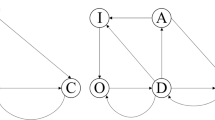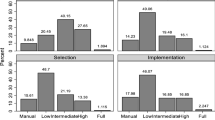Abstract
Herbert Packer’s models of the criminal process are criminal justice theorems, often the foundation of student introduction to the field in introductory textbooks. To date, there is little empirical analysis of the conceptual foundations of the process-based models, namely that courts are more efficient through the utilization of plea bargains, while an increase in trials necessarily decreases efficiency. The present results reveal wide variability in Florida circuit criminal court efficiency within and between circuits from 2004/05 to 2010/11. Regression analysis revealed that the year over year difference in both plea bargain (β = .14) and trial percentage (β = .13) significantly predicted (p < .05) year over year changes in efficiency, but explained a small amount of the variance (R 2 = .026) controlling for other factors (total model R 2 = .58–.62). These results show there is more capacity for trials within the Florida courts, and an increase in trials does not negatively impact court efficiency as expected but that other factors are far more relevant in explaining changes in efficiency outcomes. Furthermore, the Packer “assembly line” analogy, a basic tenet of the criminal process, is not found: plea bargains do not strongly predict or explain court efficiency, with structures playing a greater role in court outcomes than the processes conceptualized by Packer. The application to courts and impact on criminal justice education are discussed.

Similar content being viewed by others
References
Albanese, J. S. (2012). Criminal justice (5th ed.). New Jersey: Pearson/Prentice Hall.
Alschuler, A. W. (1983). Implementing the criminal defendant’s right to trial: alternatives to the plea bargaining system. The University of Chicago Law Review, 50(3), 931–1050.
Athanassopoulos, A. D., & Curram, S. P. (1996). A comparison of data envelopment analysis and artifical neural networks as tools for assessing the efficiency of decision making units. The Journal of the Operational Research Society, 47(8), 1000–1016.
Beenstock, M., & Haitovsky, Y. (2004). Does the appointment of judges increase the output of the judiciary? International Review of Law and Economics, 24, 351–369.
Bohm, R. M. (2006). “McJustice”: on the McDonaldization of criminal justice. Justice Quarterly., 23(1), 127–146.
Bohm, R. M., & Haley, K. N. (2008). Introduction to criminal justice (5th ed.). Boston: McGraw-Hill.
Camanho, A. S., & Dyson, R. G. (1999). Efficiency, size, benchmarks and targets for bank branches: an application of data envelopment analysis. The Journal of the Operational Research Society, 50(9), 903–915.
Carlson, A., Harrison, K. & Hudzik, J.K. (2008). Adequate, stable, equitable and responsible trial court funding: Reframing the state vs. local debate. Report by the Justice Management Institute for the National Institute of Justice, Washington, D.C. http://www.ncjrs.gov/pdffiles1/nij/grants/223973.pdf.
Chandler, H. P. (1960). The problem of congestion and delay in the federal courts. The Annals of the American Academy of Political and Social Science, 328, 144–152.
Charnes, A., Cooper, W., & Rhodes, E. (1978). Measuring the efficiency of decision making units. European Journal of Operations Research., 2, 429–444.
Church, T. (1978). Justice delayed: The pace of litigation in urban trial courts. National Center for State Courts. Publication No. R0041.
da Conceição Sampaio de Sousa, M., & Schwengber, S.B. (2005). Efficiency estimates for judicial services in Brazil: Nonparametric FDH and the expected order-m efficiency scores for Rio Grande Do Sul Courts. Found online December 10, 2009 at: http://www.anpec.org.br/encontro2005/artigos/A05A053.pdf
Deutsch, L. (2012). Los Angeles County courts begin downsizing. AP (June 15, 2012). Found online at: http://bigstory.ap.org/article/los-angeles-county-courts-begin-downsizing.
Drake, L., & Simper, R. (2000). Productivity estimation and the size-efficiency relationship in english and welsh police forces: an application of data envelopment analysis and multiple discriminate analysis. International Review of Law and Economics, 20, 53–73.
Drake, L., & Simper, R. (2001). An economic evaluation of policing activity: an application of a hybrid methodology. European Journal of Law and Economics, 12, 173–192.
Drake, L., & Simper, R. (2002). X-efficiency and scale economies in policing: a comparative study using the distribution free approach and DEA. Applied Economics, 34, 1859–1870.
Drake, L., & Simper, R. (2003). The measurement of english and welsh police force efficiency: a comparison of distance function models. European Journal of Operational Research, 147, 165–186.
Drake, L., & Simper, R. (2004). The economics of managerialism and the drive for efficiency in policing. Managerial and Decision Economics, 25, 509–523.
Duff, P. (1998). Crime control, due process and the case for the prosecution. British Journal of Criminology, 38(4), 611.
Eisenstein, J. (1973). Politics and the legal process. New York: Harper & Row.
Eisenstein, J., & Jacob, H. (1977). Felony justice: An organizational analysis of criminal courts. Boston: Little Brown & Company.
Feeley, M. M. (1973). Two models of the criminal justice system: an organizational perspective. Law and Society Review., 7(3), 407–426.
Ferrandino, J. (2012a). The impact of revision 7 on the technical efficiency of Florida’s circuit courts. Justice System Journal., 33(1), 22–46.
Ferrandino, J. (2012b). The comparative technical efficiency of Florida’s campus police departments. Criminal Justice Review., 37(3), 301–318.
Flango, V.E., & Ostrom, B.J. (1996). Assessing the need for judges and court support staff. National Center for State Courts. ISBN: 0-89656-162-3.
Florida Department of Law Enforcement (FDLE, n.d.). Crime and Arrest Data. Available online at http://www.fdle.state.fl.us/Content/FSAC/UCR/UCR-Home.aspx.
Florida State Courts (n.d.). Historical Judgeship Certification Chart. Found online at http://www.flcourts.org/gen_public/stats/bin/CircuitJudgeswithdatesMarch2012.pdf
Florida State Courts Annual Report (2003–04).http://www.flcourts.org/gen_public/pubs/bin/courts_annual_report04.pdf (last accessed June 2009).
Florida State Courts Summary Reporting System (n.d.). Florida Trial Court Statistics. Found online at: http://trialstats.flcourts.org/
Glick, H. R. (1983). Courts, politics and justice. New York: McGraw-Hill.
Goldstein, A. S. (1974). Reflections on two models: inquisitorial themes in American criminal procedure. Stanford Law Review, 26(5), 1009–1025.
Gorman, M. F., & Ruggiero, J. (2009). Evaluating US judicial district prosecutor performance using DEA: are more disadvantaged counties more inefficient? European Journal of Law and Economics, 27, 275–283.
Griffiths, J. (1970). Ideology in criminal procedure or a third “model” of the criminal process. The Yale Law Journal., 79(3), 359–417.
Hall, D. J., Tobin, R. W., & Pankey, K. G., Jr. (2004). Balancing judicial independence and fiscal accountability in times of economic crisis. Judge’s Journal., 43(3), 5–9.
Heydebrand, W. V. (1977). The context of public bureaucracies: an organizational analysis of federal district courts. Law & Society Review., 11(5), 759–821.
Historical Statewide Judgeship Table (2012). Available online at: http://www.flcourts.org/gen_public/stats/bin/LAjudgeships3-12.pdf.
Holmes, M. D., Daudistel, H. C., & Taggart, W. A. (1992). Plea bargaining policy and state district court caseloads: an interrupted time series analysis. Law & Society Review., 26(1), 139–160.
Kittelson, S. A. C., & Forsund, F. R. (1992). Efficiency analysis of Norwegian district courts. Journal of Productivity Analysis, 3, 277–306.
Lewin, A. Y., Morey, R. C., & Cook, T. J. (1982). Evaluating the administrative efficiency of courts. Omega: The International Journal of Management Science., 10(4), 401–411.
Louthan, W. C. (1979). The politics of justice: A study in law, social science and public policy. Port Washington: National University Publications.
McConville, M., & Mirsky, C. (1995). Guilty plea courts: a social disciplinary model of criminal justice. Social Problems, 42(2), 216–234.
Medlin, J. & Billings, R.B. (2003). Judicial independence requires more resources and greater management flexibility. The North Carolina Bar State Journal. Summer: 8–15.
Mohr, L. B. (1976). Organizations, decisions and courts. Law and Society Review., 10(4), 621–642.
Moore, A., Nolan, J., & Segal, G. F. (2005). Putting out the trash: measuring municipal service efficiency in US cities. Urban Affairs Review., 41, 237–259.
Nardulli, P. F. (1978). The courtroom elite. Cambridge: Ballinger.
Nyhan, R. C. (2002). Benchmarking tools: an application to juvenile justice facility performance. The Prison Journal, 82(4), 423–439.
Nyhan, R. C., & Martin, L. L. (1999a). Comparative performance measurement: a primer on data envelopment analysis. Public Productivity and Management Review., 22(3), 348–364.
Nyhan, R. C., & Martin, L. L. (1999b). Assessing the performance of municipal police services using data envelopment analysis: an exploratory study. State and Local Government Review., 31, 18–30.
Ostrom, B.J., & Hanson, R.A. (1999). Efficiency, timeliness and quality: A new perspective from nine state criminal trial courts. National Institute of Justice and State Justice Institute. ISBN: 0-89656-199-2.
Packer, H. (1964). Two models of the criminal process. University of Pennsylvania Law Review., 113(1), 1–68.
Packer, H. (1968). The limits of the criminal sanction. Stanford: Stanford University Press.
Philippino House of Representatives (2004). Improving judicial efficiency. Policy Advisory No. 2004–02, Congressional Planning and Budget Department.
Roach, K. (1999). Four models of the criminal process. The Journal of Criminal Law and Criminology, 89(2), 671–716.
Rowles, J.P., Mackey, C., & McMillan, J.E. (1993). Court efficiency in the Bahamas: Analysis of major problems and suggested solutions. National Center for State Courts.
Rubinstein, M. L., & White, T. J. (1979). Alaska’s ban on plea bargaining. Law & Society Review., 13(2), 367–383.
Rudolf, J. (2012). Pennsylvania public defenders rebel against crushing caseloads. Huffington Post (June 16, 2012). Found online at http://www.huffingtonpost.com/2012/05/30/pennsylvania-public-defenders_n_1556192.html.
Santobello v. New York (1971) (404 U.S. 257).
Scheingold, S. A., & Gressett, L. A. (1987). Policy, politics, and the criminal courts. American Bar Foundation Research Journal., 12(2/3), 461–505.
Schick, R. P. (1926). Simplifying criminal procedure in the lower courts. The Annals of the American Academy of Political and Social Science, 125, 112–119.
Schmalleger, F. (2008). Criminal justice: A brief introduction (7th ed.). Upper Saddle River: Pearson/Prentice Hall.
Schneider, M. R. (2005). Judicial career incentives and court performance: an empirical study of the German Labour Courts of Appeal. European Journal of Law and Economics, 20, 127–144.
Schulhofer, S. J. (1985). No job too small: justice without bargaining in the lower criminal courts. American Bar Foundation Research Journal., 10(3), 519–598.
Scott, W. R., & Davis, G. S. (2007). Organizations and organizing: Rational, natural and open systems perspectives. New Jersey: Pearson-Prentice Hall.
SPSS 20. IBM.
Sun, S. (2002). Measuring the relative efficiency of police precincts using data envelopment analysis. Socio-Economic Planning Sciences, 36, 51–71.
Sunderland, L. V. (1980). Liberals, conservatives, and the exclusionary rule. The Journal of Criminal Law and Criminology, 71(4), 343–377.
Tulkens, H. (1993). On FDH efficiency analysis: some methodological issues and applications to retail banking, courts and urban transit. Journal of Productivity Analysis, 4, 183–210.
Uekert B.K., Douglas, J., Schauffler, R., Kleiman, S., Maggard, M., & Stenjborn, P. (2006). West Virginia circuit court judicial workload assessment: Final report. National Center for State Courts and State Justice Institute: SJI-06-N-075.
Verma, A., & Gavirneni, S. (2006). Measuring police efficiency in India: an application of data envelopment analysis. Policing: An International Journal of Police Strategies and Management., 29, 125–145.
Walker, S. (2012). Sense and nonsense about crime, drugs and community (7th ed.). Australia: Wadsworth.
Acknowledgments
The author would like to thank the Office of the Executive Vice Chancellor at Indiana University-Northwest for funding this research through a Summer Research Fellowship.
Author information
Authors and Affiliations
Corresponding author
Rights and permissions
About this article
Cite this article
Ferrandino, J. Testing the Packer Theorem: The Efficiency of Florida’s Criminal Circuit Courts. Am J Crim Just 39, 375–393 (2014). https://doi.org/10.1007/s12103-013-9207-5
Received:
Accepted:
Published:
Issue Date:
DOI: https://doi.org/10.1007/s12103-013-9207-5




